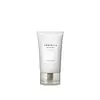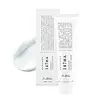What's inside
What's inside
 Key Ingredients
Key Ingredients

 Benefits
Benefits

 Concerns
Concerns

 Ingredients Side-by-side
Ingredients Side-by-side

Water
Skin ConditioningGlycerin
HumectantPropanediol
SolventDipropylene Glycol
HumectantCyclopentasiloxane
EmollientCentella Asiatica Extract
Cleansing1,2-Hexanediol
Skin ConditioningCyclohexasiloxane
EmollientTrehalose
HumectantCaprylyl Methicone
Skin ConditioningC12-14 Pareth-12
EmulsifyingCarbomer
Emulsion StabilisingTromethamine
BufferingC30-45 Alkyl Cetearyl Dimethicone Crosspolymer
EmollientAmmonium Acryloyldimethyltaurate/Vp Copolymer
Butylene Glycol
HumectantXanthan Gum
EmulsifyingZingiber Officinale Root Extract
MaskingMentha Piperita Leaf Extract
Skin ConditioningEthylhexylglycerin
Skin ConditioningDipotassium Glycyrrhizate
HumectantTranexamic Acid
AstringentDextrin
AbsorbentTheobroma Cacao Seed Extract
AntioxidantLeuconostoc/Radish Root Ferment Filtrate
AntimicrobialBiosaccharide Gum-1
HumectantDisodium EDTA
Sodium Hyaluronate
HumectantBeta-Glucan
Skin ConditioningHydrogenated Lecithin
EmulsifyingCoptis Chinensis Root Extract
AntioxidantCetearyl Alcohol
EmollientStearic Acid
CleansingCeramide NP
Skin ConditioningCeramide Ng
Skin ConditioningCholesterol
EmollientPhytosphingosine
Skin ConditioningCeramide As
Skin ConditioningCeramide AP
Skin ConditioningCeramide EOP
Skin ConditioningWater, Glycerin, Propanediol, Dipropylene Glycol, Cyclopentasiloxane, Centella Asiatica Extract, 1,2-Hexanediol, Cyclohexasiloxane, Trehalose, Caprylyl Methicone, C12-14 Pareth-12, Carbomer, Tromethamine, C30-45 Alkyl Cetearyl Dimethicone Crosspolymer, Ammonium Acryloyldimethyltaurate/Vp Copolymer, Butylene Glycol, Xanthan Gum, Zingiber Officinale Root Extract, Mentha Piperita Leaf Extract, Ethylhexylglycerin, Dipotassium Glycyrrhizate, Tranexamic Acid, Dextrin, Theobroma Cacao Seed Extract, Leuconostoc/Radish Root Ferment Filtrate, Biosaccharide Gum-1, Disodium EDTA, Sodium Hyaluronate, Beta-Glucan, Hydrogenated Lecithin, Coptis Chinensis Root Extract, Cetearyl Alcohol, Stearic Acid, Ceramide NP, Ceramide Ng, Cholesterol, Phytosphingosine, Ceramide As, Ceramide AP, Ceramide EOP
Water
Skin ConditioningGlycerin
HumectantDipropylene Glycol
HumectantCetearyl Alcohol
EmollientHydrogenated Poly(C6-14 Olefin)
EmollientHydrogenated Polydecene
EmollientCaprylic/Capric Triglyceride
MaskingCyclopentasiloxane
EmollientDimethicone
Emollient1,2-Hexanediol
Skin ConditioningVegetable Oil
Skin ConditioningBetaine
HumectantGlyceryl Stearate Se
EmulsifyingCetearyl Olivate
Cyclohexasiloxane
EmollientSorbitan Olivate
EmulsifyingC12-16 Alcohols
EmollientCetearyl Glucoside
EmulsifyingHydrogenated Lecithin
EmulsifyingDimethiconol
EmollientSqualane
EmollientButylene Glycol
HumectantLaminaria Japonica Extract
Skin ProtectingEclipta Prostrata Leaf Extract
Skin ConditioningPalmitic Acid
EmollientHydrogenated Polyisobutene
EmollientCeramide NP
Skin ConditioningPanthenol
Skin ConditioningC12-15 Alkyl Benzoate
AntimicrobialArgania Spinosa Kernel Oil
EmollientIsononyl Isononanoate
EmollientPolyglyceryl-10 Stearate
Skin ConditioningPelargonium Graveolens Flower Oil
MaskingSodium Hyaluronate
HumectantButyrospermum Parkii Butter
Skin ConditioningPolyglyceryl-2 Dipolyhydroxystearate
Skin ConditioningStearic Acid
CleansingFructooligosaccharides
HumectantPolyquaternium-51
Skin ConditioningBeta-Glucan
Skin ConditioningMelia Azadirachta Leaf Extract
Skin ConditioningDisodium EDTA
Melia Azadirachta Flower Extract
Skin ConditioningAmaranthus Caudatus Seed Extract
Skin ConditioningUlmus Davidiana Root Extract
Skin ConditioningCarnosine
Skin ConditioningMicrocrystalline Cellulose
AbsorbentCoccinia Indica Fruit Extract
Skin ConditioningInulin Lauryl Carbamate
Emulsion StabilisingHydrolyzed Hyaluronic Acid
HumectantGlucose
HumectantGlyceryl Stearate
EmollientPEG-100 Stearate
Centella Asiatica Extract
CleansingFicus Carica Fruit Extract
HumectantHydroxyethyl Acrylate/Sodium Acryloyldimethyl Taurate Copolymer
Emulsion StabilisingAloe Barbadensis Flower Extract
EmollientSolanum Melongena Fruit Extract
Skin ConditioningCellulose Gum
Emulsion StabilisingDisodium Stearoyl Glutamate
CleansingOcimum Sanctum Leaf Extract
Skin ConditioningGuaiazulene
AntimicrobialPolysorbate 60
EmulsifyingCorallina Officinalis Extract
Skin ConditioningCurcuma Longa Root Extract
MaskingPhenoxyethanol
PreservativeSorbitan Isostearate
EmulsifyingEthylhexylglycerin
Skin ConditioningBeta Vulgaris Root Extract
Skin ConditioningChamaecyparis Obtusa Leaf Extract
Skin ConditioningOligopeptide-1
Skin ConditioningWater, Glycerin, Dipropylene Glycol, Cetearyl Alcohol, Hydrogenated Poly(C6-14 Olefin), Hydrogenated Polydecene, Caprylic/Capric Triglyceride, Cyclopentasiloxane, Dimethicone, 1,2-Hexanediol, Vegetable Oil, Betaine, Glyceryl Stearate Se, Cetearyl Olivate, Cyclohexasiloxane, Sorbitan Olivate, C12-16 Alcohols, Cetearyl Glucoside, Hydrogenated Lecithin, Dimethiconol, Squalane, Butylene Glycol, Laminaria Japonica Extract, Eclipta Prostrata Leaf Extract, Palmitic Acid, Hydrogenated Polyisobutene, Ceramide NP, Panthenol, C12-15 Alkyl Benzoate, Argania Spinosa Kernel Oil, Isononyl Isononanoate, Polyglyceryl-10 Stearate, Pelargonium Graveolens Flower Oil, Sodium Hyaluronate, Butyrospermum Parkii Butter, Polyglyceryl-2 Dipolyhydroxystearate, Stearic Acid, Fructooligosaccharides, Polyquaternium-51, Beta-Glucan, Melia Azadirachta Leaf Extract, Disodium EDTA, Melia Azadirachta Flower Extract, Amaranthus Caudatus Seed Extract, Ulmus Davidiana Root Extract, Carnosine, Microcrystalline Cellulose, Coccinia Indica Fruit Extract, Inulin Lauryl Carbamate, Hydrolyzed Hyaluronic Acid, Glucose, Glyceryl Stearate, PEG-100 Stearate, Centella Asiatica Extract, Ficus Carica Fruit Extract, Hydroxyethyl Acrylate/Sodium Acryloyldimethyl Taurate Copolymer, Aloe Barbadensis Flower Extract, Solanum Melongena Fruit Extract, Cellulose Gum, Disodium Stearoyl Glutamate, Ocimum Sanctum Leaf Extract, Guaiazulene, Polysorbate 60, Corallina Officinalis Extract, Curcuma Longa Root Extract, Phenoxyethanol, Sorbitan Isostearate, Ethylhexylglycerin, Beta Vulgaris Root Extract, Chamaecyparis Obtusa Leaf Extract, Oligopeptide-1
 Reviews
Reviews

Ingredients Explained
These ingredients are found in both products.
Ingredients higher up in an ingredient list are typically present in a larger amount.
1,2-Hexanediol is a synthetic liquid and another multi-functional powerhouse.
It is a:
- Humectant, drawing moisture into the skin
- Emollient, helping to soften skin
- Solvent, dispersing and stabilizing formulas
- Preservative booster, enhancing the antimicrobial activity of other preservatives
Beta-Glucan is a polysaccharide. It can be derived from the cell walls of seaweed, oats, yeast, and fungi. It hydrates the skin and helps boost your skin's natural barrier.
As an antioxidant, beta-glucan helps fight free-radicals. Free-radicals are molecules that may damage your skin cells, such as pollution.
Studies show this ingredient may be an effective wrinkle reducer as it can deeply penetrate into skin. It has also been show to help with wound healing.
Learn more about Beta-GlucanButylene Glycol (or BG) is used within cosmetic products for a few different reasons:
Overall, Butylene Glycol is a safe and well-rounded ingredient that works well with other ingredients.
Though this ingredient works well with most skin types, some people with sensitive skin may experience a reaction such as allergic rashes, closed comedones, or itchiness.
Learn more about Butylene GlycolCentella Asiatica Extract (Centella) is derived from an herb native to Southeast Asia. It is famous for its anti-inflammatory and soothing properties.
Centella is rich in antioxidants and amino acids, such as Madecassic Acid and Asiaticoside.
Studies show the compounds in centella help with:
The combination of all these properties makes centella effective at soothing, hydrating, and protecting the skin.
Other great components of centella include Vitamin A, vitamin C, several B vitamins, and Asiatic Acid.
Fun fact: Centella has been used as a medicine and in food for many centuries. As a medicine, it is used to treat burns, scratches, and wounds.
Learn more about Centella Asiatica ExtractCeramide NP is a type of ceramide and formally known as ceramide 3.
Ceramides are intercellular lipids naturally found in our skin that bonds dead skin cells together to create a barrier. They are known for their ability to hold water and thus are a great ingredient for dry skin.
Ceramides are an important building block for our skin barrier. A stronger barrier helps the skin look more firm and hydrated. By bolstering the skin ceramides act as a barrier against irritating ingredients. This can help with inflammation as well.
If you would like to eat ceramides, sweet potatoes contain a small amount.
Read more about other common types of ceramides here:
Ceramide AP
Ceramide EOP
Cetearyl alcohol is a mixture of two fatty alcohols: cetyl alcohol and stearyl alcohol. It is mainly used as an emulsifier. Emulsifiers help prevent the separation of oils and products. Due to its composition, it can also be used to thicken a product or help create foam.
Cetearyl alcohol is an emollient. Emollients help soothe and hydrate the skin by trapping moisture.
Studies show Cetearyl alcohol is non-toxic and non-irritating. The FDA allows products labeled "alcohol-free" to have fatty alcohols.
This ingredient is usually derived from plant oils such as palm, vegetable, or coconut oils. There is debate on whether this ingredient will cause acne.
Due to the fatty acid base, this ingredient may not be Malassezia folliculitis safe.
Learn more about Cetearyl AlcoholCyclohexasiloxane is a type of silicone more commonly known as D6. It is an emollient and solvent.
Cyclohexasiloxane is used to evenly distribute ingredients throughout the product. When applied to the skin, Cyclohexasiloxane evaporates and leaves behind a silky feel.
As an emollient, it can help the skin feel soft and hydrated. It is also used to reduce frizz in hair products.
Learn more about CyclohexasiloxaneCyclopentasiloxane, or D5, is a silicone used to improve texture of products and trap moisture.
D5 is considered lightweight and volatile. Volatile means it evaporates quickly after application. Once evaporated, D5 leaves a thin barrier that helps keep skin hydrated.
It is also an emollient. Emollients help soften the skin and prevent water loss. Silicones create a silky texture in products. D5 helps other ingredients become more spreadable.
Studies show D5 is safe to use in skincare products. We recommend speaking with a skincare professional if you have concerns.
Learn more about CyclopentasiloxaneDipropylene Glycol is a synthetically created humectant, stabilizer, and solvent.
This ingredient helps:
Dipropylene glycol is technically an alcohol, but it belongs to the glycol family (often considered part of the ‘good’ alcohols). This means it is hydrating and gentle on skin unlike drying solvent alcohols like denatured alcohol.
As a masking agent, Dipropylene Glycol can be used to cover the smell of other ingredients. However, it does not have a scent.
Studies show Dipropylene Glycol is considered safe to use in skincare.
Learn more about Dipropylene GlycolDisodium EDTA plays a role in making products more stable by aiding other preservatives.
It is a chelating agent, meaning it neutralizes metal ions that may be found in a product.
Disodium EDTA is a salt of edetic acid and is found to be safe in cosmetic ingredients.
Learn more about Disodium EDTAEthylhexylglycerin (we can't pronounce this either) is commonly used as a preservative and skin softener. It is derived from glyceryl.
You might see Ethylhexylglycerin often paired with other preservatives such as phenoxyethanol. Ethylhexylglycerin has been found to increase the effectiveness of these other preservatives.
Glycerin is already naturally found in your skin. It helps moisturize and protect your skin.
A study from 2016 found glycerin to be more effective as a humectant than AHAs and hyaluronic acid.
As a humectant, it helps the skin stay hydrated by pulling moisture to your skin. The low molecular weight of glycerin allows it to pull moisture into the deeper layers of your skin.
Hydrated skin improves your skin barrier; Your skin barrier helps protect against irritants and bacteria.
Glycerin has also been found to have antimicrobial and antiviral properties. Due to these properties, glycerin is often used in wound and burn treatments.
In cosmetics, glycerin is usually derived from plants such as soybean or palm. However, it can also be sourced from animals, such as tallow or animal fat.
This ingredient is organic, colorless, odorless, and non-toxic.
Glycerin is the name for this ingredient in American English. British English uses Glycerol/Glycerine.
Learn more about GlycerinHydrogenated Lecithin is created from the hydrogenation of lecithin (a group of phospholipids). Hydrogenation is a chemical reaction between hydrogen and another element.
This ingredient is an emollient and emulsifier. As an emollient, it helps soften skin by trapping moisture within. As an emulsifier, it prevents oil and water ingredients from separating.
Sodium Hyaluronate is hyaluronic acid's salt form. It is commonly derived from the sodium salt of hyaluronic acid.
Like hyaluronic acid, it is great at holding water and acts as a humectant. This makes it a great skin hydrating ingredient.
Sodium Hyaluronate is naturally occurring in our bodies and is mostly found in eye fluid and joints.
These are some other common types of Hyaluronic Acid:
Learn more about Sodium HyaluronateStearic Acid is a fatty acid. It is an emollient, emulsifier, and texture enhancer.
As an emollient, stearic acid helps soften skin. It aids the skin's protective barrier by preventing water loss. It also provides a gentle cleansing effect without stripping away natural oils.
Stearic acid may also be used to enhance the texture of products. It can add volume and stabilize ingredients such as water and oil. This can help water and oil ingredients from separating.
Sources of stearic acid include animal or vegetable fats/oils such as coconut or shea. It can be naturally found in butter, cocoa butter, shea butter, vegetable fats, and animal tallow.
This ingredient may not be Malassezia folliculitis, or fungal-acne safe.
Learn more about Stearic AcidWater. It's the most common cosmetic ingredient of all. You'll usually see it at the top of ingredient lists, meaning that it makes up the largest part of the product.
So why is it so popular? Water most often acts as a solvent - this means that it helps dissolve other ingredients into the formulation.
You'll also recognize water as that liquid we all need to stay alive. If you see this, drink a glass of water. Stay hydrated!
Learn more about Water